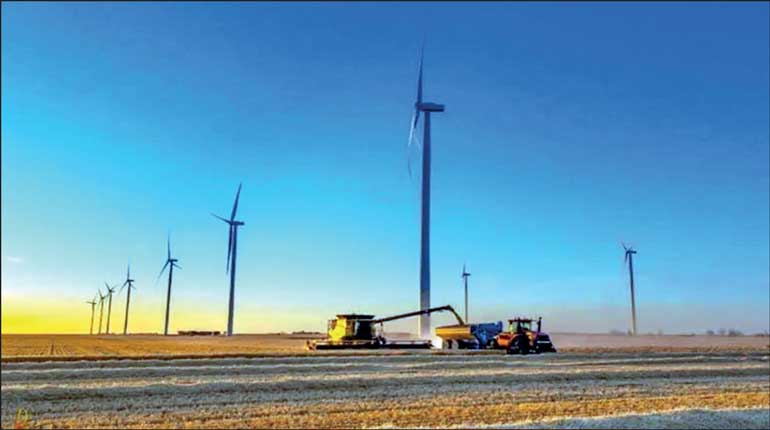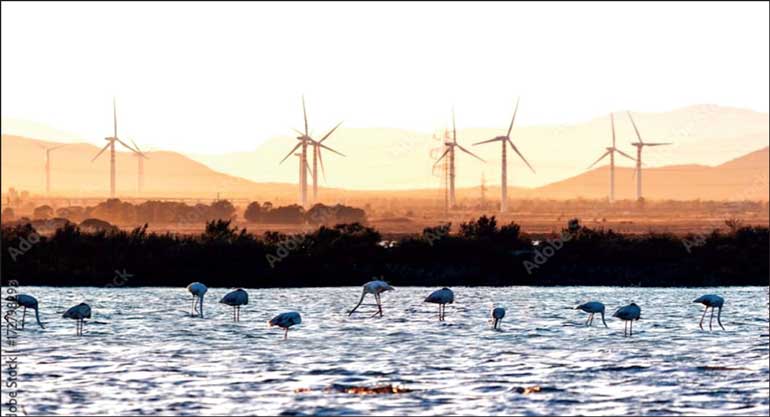Friday Dec 05, 2025
Friday Dec 05, 2025
Wednesday, 7 May 2025 00:22 - - {{hitsCtrl.values.hits}}

Wind farm and agriculture

Wind farm and wetlands - Sardinia
 This is a rebuttal to the article titled “Policy brief for Sri Lankan Govt.: Call to re-evaluate wind energy strategies for sustainable future” by Hiran Daluwatta (HD) that was published in the DFT on 21 April 2025 (https://www.ft.lk/opinion/Policy-brief-for-Sri-Lankan-Govt-Call-to-re-evaluate-wind-energy-strategies-for-sustainable-future/14-775601).
This is a rebuttal to the article titled “Policy brief for Sri Lankan Govt.: Call to re-evaluate wind energy strategies for sustainable future” by Hiran Daluwatta (HD) that was published in the DFT on 21 April 2025 (https://www.ft.lk/opinion/Policy-brief-for-Sri-Lankan-Govt-Call-to-re-evaluate-wind-energy-strategies-for-sustainable-future/14-775601).
HD presents wind power in negative light with erroneous remarks and claims that wind energy is not the optimal solution for achieving long-term energy security for SL.
Responses to opinions expressed by HD are presented below:
Relevance of wind power
Harnessing wind resources remains a priority for SL in the endeavour to attain renewable energy dominance within the next decade.
Studies on wind resources in SL, technological advances in the wind industry, and operational experience of wind farms globally and in SL makes further development of wind power an attractive proposition.
As of 2024, the installed wind power capacity in SL is 267 MW with the CEB operating a 103.5 MW capacity plant in Mannar and IPPs operating plants totalling 163.5 MW of capacity in Puttalam, Kilinochchi and Mannar.
Concerns about “inconsistent and weak winds”
HD’s outlandish remark, “undeniable constraint of inconsistent and weak winds” does not align with the continuing and fast paced development of wind resources in southern India that shares a similar monsoon seasons driven wind characteristic experienced in SL.
Studies conducted in Sri Lanka to date have indicated a theoretical potential to harness up to 20,000 MW of land-based wind power capacity. A 2017 report by ADB titled Assessment of Sri Lanka’s Power Sector-100 percent Electricity Generation through Renewable Energy by 2050, allotted 15,000 MW of capacity to be met through wind energy.
As the demand for wind power has grown, the wind industry has evolved rapidly with technological advances contributing to the emergence of larger, more efficient machines that have led to a reduced cost of energy generated.
HD’s claim, “Sri Lankan wind farms often perform at 20-25%, leading to low efficiency and questionable returns on investment” is well off the mark. As per that performance data of wind projects owned by Sri Lankan wind plant developer/operator Windforce, projects in Puttalam that were commissioned 10 to 15 years ago recorded capacity factors in the range of 25 to 33%, while projects in Kilinochchi that were commissioned over 10 years ago recorded capacity factors above 35% and a project in Mannar that was commissioned over two years ago has recorded capacity factors above 45%.
The CEB owned and operated 103.5 MW wind plant in Mannar that was commissioned in the year 2021, has recorded plant factors above 40%.
Utility scale wind turbines in use today are multi-MW in capacity with hub heights reaching 100m or above with large rotor diameters to maximise the energy capture. They are designed to operate in zones with moderate wind regimes and wind farms operated in the north, northwest, north central and southwest regions of SL can yield capacity factors above 40%.
Looming uncertainty of monsoons
While wind resource variation on an annual basis is to be expected, the directional variability of the wind resource is seen with the southwest and northeast monsoon seasons as is the case in South India. Significant seasonal variations outside this historic pattern has not been validated scientifically and therefore the concern expressed by HD has no merit.
Land scarcity
Suitable land for wind resource harnessing represents about 6% of the total land area of SL (65,600 sq. km). This quantum of land could support almost 20,000 MW of potential installed capacity (Sustainable Energy Authority).
A wind farm featuring modern high-capacity turbines located on “topographically flat” terrain will require about 15 hectares per MW in terms of land spread with the turbines spaced far apart for enhanced performance. The actual footprint of the wind farm that includes foundations, substation, access roads, etc. will be less than 3% of the extent of spread on the land. Thus, the land can be subject to dual use such as agriculture, animal husbandry, forestry, process industries, etc. This is commonly seen worldwide with the landowner (farmer, rancher, etc.) benefiting from revenue for leasing the land occupied by the wind project operator.
Heavy burden of grid integration and transmission losses
A plan to develop utility scale wind and solar power will require the extension of the electric transmission system into the zones rich in wind and solar resources. The cost of building the
transmission network will be viable when the quantum of electricity to be harnessed and transmitted is sufficient to justify the expense.
With reference to HD’s concern about “significant costs on the national grid due to reactive power compensation, frequency management challenges, and load balancing difficulties,” he should be aware that modern wind turbines use power electronic converters to actively inject or absorb reactive power. They can operate in modes such as voltage control, power factor control and reactive power setpoint. These features dynamically support the grid’s voltage and stability needs.
Additionally, increased use of battery energy storage systems (BESS) is seen worldwide for grid support and efficient energy utilisation where a significant quantum of variable renewable energy is harnessed. Increased use of BESS in combination with wind and solar is taking place in India as well. The same should be the case in Sri Lanka.
Threat to migratory birds
Wind turbines pose a threat to avian life if they are carelessly sited in zones rich in avian habitats. Adequate studies that highlight negative impacts with effective practical steps taken to mitigate them are mandatory. Avian migratory paths must be identified and wind turbine setback rules established based on zones of avian congregation.
There will be a temporary environmental impact during the project construction phase due to increased human presence (construction work) and heavy traffic flow (equipment transport). Additionally, avian impact effects during project operational phase must continue with observations, gathering of data and implementation of mitigatory measures.
Avian sensitive locations such as Mannar have a seasonal characteristic with migratory bird presence observed during the dry season (low wind). Shutting off wind farm operations during heavy avian presence is an option and the use of radar to detect a flock of birds approaching a wind farm and shutting off turbines located on the likely path of interception is also an effective mitigatory measure. A radar system is installed at the CEB wind project in Mannar.
The operation of wind farms in avian activity rich locations is common. The Mediterranean islands of Corsica, Cyprus, and Sardinia feature wind farms where flamingo tourism is a popular activity. The environmental permitting methodology adopted by the authorities on these islands to protect avian activity while allowing the development and operation of wind farms is worth studying. This will help SL authorities and stakeholders when formulating rules for permitting and developing mitigatory measures.
Solar PV through rooftops and agrivoltaics
The advance of solar power and battery storage technologies offer great promise in SL with distributed solar power at utility scale and industrial, commercial, and residential prosumers (roof top solar) offering significant scale up potential. However, solar has drawbacks such as land footprint impact, roof top limitations and plant factors around 20%. Solar complements wind in the renewable energy mix and these two elements will play a significant role when attaining renewable energy dominance within the next decade.
Concluding remarks
HD has crafted a narrative that misleads the layperson with exaggerated expressions of concern while lacking knowledge of the wind industry.
Wind power development in SL will continue to face challenges on the land acquisition front, environmental permitting, investment, transport logistics, etc., However, the experiences gained on the development, construction and operation of the existing projects and the entry of new players as developers, EPC contractors and turbine suppliers will boost the industry for increasing wind power capacity in line with the requirement for SL to attain renewable energy dominance.
(The writer is a Management Consultant and Renewable Energy Specialist. He can be reached via email: [email protected].)